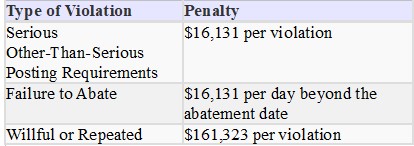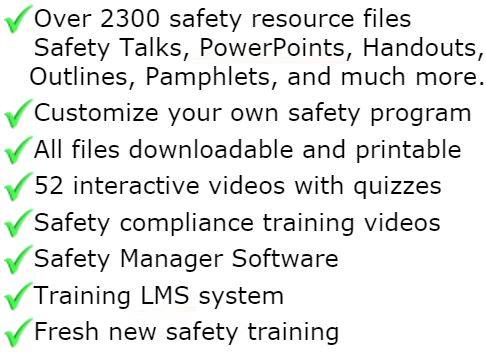
2 Minute Safety Training Safety Talk
This is a sample or partial document
Download the full customizable and printable version
Hand Safety - Avoiding Finger, Hand, and Wrist Injuries
Whether you're a machine operator, a lab technician, an office worker--any kind of worker, for that matter--your hands are one of your most important "instruments." Yet, over a quarter of a million people suffer serious (and often disabling) hand injuries each year. By recognizing hand hazards, following established safety guidelines, and using protective guards, shields, gloves and other personal protective devices as needed, you can save your hands from injury and yourself from unnecessary disability.
Recognizing Hand Hazards
One of the most serious yet common causes of hand injury is the use of unprotected or faulty machinery or equipment. Failure to use push-sticks, guards, kill-switches, or to follow appropriate lock-out procedures are among the leading industrial hand hazards. Wearing jewelry, gloves, or loose-fitting clothing around moving parts can also lead to injury. Chemicals, corrosives, and other irritating substances can cause burns and skin inflammation unless appropriate hand protection is used. Temperature extremes and electrical hazards are other common causes of hand injuries. In addition, constant, repetitive motion (as in assembly-line work or painting) can cause undue stress on the wrists and hands unless protective measures are taken. The following list provides a guideline for hand safety that can help you protect your hands from injury and disability.
Hand Protection Checklist
1. Be alert to potential hand hazards before an accident can happen.
2. Be alert to possible unguarded pinch points.
3. Always use push-sticks, guards, shields, and other protective devices when appropriate. Do not remove guards.
4. Use brushes to wipe away debris.
5. Inspect equipment and machinery before and after tasks to make sure that it is in good operating condition.
6. Disconnect power and follow established lock-out procedures before repairing or cleaning machinery.
7. Never wear gloves, jewelry, or loose clothing when working with moving machine parts.
8. Use the appropriate personal protective equipment--gloves, guards, forearm cuffs, barrier creams--for the specific task you are performing.
9.When wearing gloves, be sure they fit properly and are rated for the specific task you are performing.
10. Select tools designed to keep wrists straight to help avoid repetitive motion/overuse problems.

GET INSTANT ACCESS
to THE MEMBERS LIBRARY
Safety materials created by safety professionals.
Access to the Safety Manager software.
Wide variety of safety videos and courses.
**Brand New** Safety Training Management System
Pre-Made Safety Materials Ready For Use
Created by experienced safety professionals & risk consultants. Saving you time, money, and risk of injuries.
95% of the work already done.
Below are the maximum penalty amounts, with the annual adjustment for inflation, that may be assessed after Jan. 15, 2024. (See OSHA Memo, Jan. 8, 2024).

**New OSHA HEAT 90 DAY**
>>Download Free HERE<<
**New 2024 OSHA 300 Form**
>>Download Free HERE<<
**Brand New**
Free with full membership subscription
Training LMS System
Ask The Safety Consultant
Safety Equipment Deal Finder

“SafetyInfo.com is the first go-to website for safety professionals and companies to use in establishing a solid safety program"
-Mike McKenzie, Certified Safety & Health Manager (CSHM), McSafety Solutions™
Note: You must have a full subscription to the Safety Library in order to use this material. Any use outside of your organization, for resell, or without an active membership is strictly prohibited and may result in prosecution under copyright infringement laws. Please contact us first, if you would be interested in reselling or using our materials for reproduction.
Inside the Members Library
Topic Index
Accident Prevention
Air Quality
Asbestos
Bloodborne Pathogens
Boilers
Chemical Safety
Compressed Gas
Confined Space
Construction
Construction Worksite
Cranes & Slings
Driver / Fleet Safety
Drug Free Workplace
Electrical
Emergency Management
Engineering Safety
Environmental
Equipment
Ergonomics
Fall Protection
Fire Safety & Prevention
First Aid
Flammable Materials
Forklifts
Hazard Communication
Hazardous Materials
Hearing Protection
Heat Stress
Hot Work
Housekeeping
Job Safety Analysis
Laboratory
Ladders
Lead
Lockout-Tagout
Machinery & Equipment
Material Handling
MSDS (SDS)
Medical & First Aid
Occupational Health
Office Safety
Off the Job Safety
Personal Protection
Process Safety
Record Keeping
Respiratory Protection
Silica Safety
Rules & Policies
Signs & Labels
Slips, Trips & Fall
Training
Terrorism Programs
Tool Safety
Vehicle & Driver
Violence Programs
Welding & Hot Work
Training Videos
Library Index
Training Materials
Videos/Courses
Talks
Articles
PowerPoint
Handouts
Training Overheads
Quizzes
Supervisor Briefs
Management Briefs
Safety Sessions
2 Minute OSHA Safety Talks
Pamphlets
First Aid Training
Supervisor Training
Hazardous Materials
Bomb Threat
Crossword Puzzles
Biological Agents
Forms & Documents
Forms
Checklists
Audit Guides
Inspections Guides
Signs & Labels
Environmental Audit Guides
Recordkeeping - OSHA 300
Sign & Label Maker
Safety Management Resources
Safety Manuals/Written Programs
Ergonomic Programs
Emergency Plans
Process Safety Management
Construction Safety
Occupational Health
Environmental
Topic Sheets
DOT Fleet-Driver
Hazardous Materials
Chemical Safety
Drug Free Workplace
Terrorism Programs
Development Guides
Safety Manager Software
Safety References & Graphics
Technical Safety Information
Posters
Topic & Fact Sheets
Development Information
Job Specific Safety Rules
Terrorism
Calculators
Safety Comic Strips
New Safety Training System
Schedule and train your employees with our materials. Add unlimited amount of employees. Record all progress and issue certificates. For group and individual training sessions.

